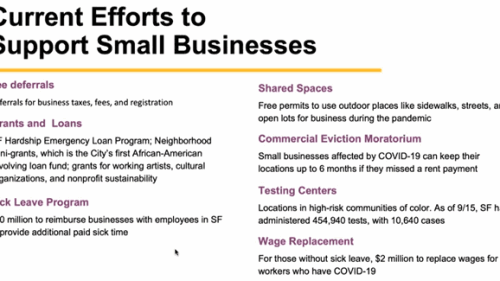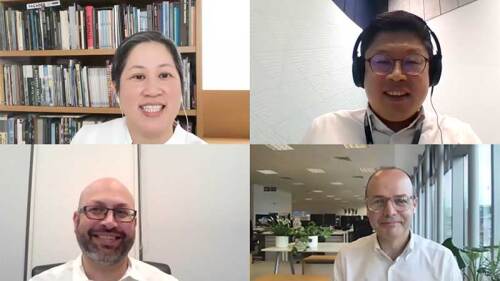Many countries in Asia have successfully mitigated the spread of COVID-19 through a range of strategies that include universal mask use, testing, sophisticated technology for contact tracing, and strict government quarantine and cleaning protocols, according to leading real estate professionals participating in a recent ULI webinar hosted by the Institute’s Building Healthy Places Initiative. The participants described impacts on their real estate businesses, and how the real estate industry has been enlisted in the fight against the coronavirus.
Moderated by Marty Burger, chief executive officer of Silverstein Properties in New York City, the webinar featured Kenneth Rhee, executive director of ULI China Mainland; Goodwin Gaw, chairman, managing principal, and founder of Gaw Capital in Hong Kong; Carrie Liu, managing director, China Life Capital Investment Company Limited in Shanghai; and ULI South Korea Chairman Junho Pok, managing director of IGIS Asset Management Company Ltd. in Seoul.
Each shared insights into how Asia’s approach to virus containment has helped expedite the reopening of businesses and public places in Mainland China, Hong Kong, and South Korea. The event was the latest in a series of webinars offered by the Institute to explore how the real estate industry is being affected by the virus and the industry’s response.
The webinar is available on demand at ULI’s Knowledge Finder.
Rhee provided an overview of the coronavirus surge and decline in the Asia Pacific region, which currently represents 15 percent of the total global cases (about 4 million) and 5 percent of the active cases (about 2.4 million). Since January, six countries—China, Vietnam, Taiwan, South Korea, Australia, and New Zealand—have all been able to flatten the curve, keeping fatalities relatively limited and sharply reducing or eliminating the number of new cases. Four other countries—India, Japan, the Philippines, and Indonesia—have yet to control the virus. Singapore has experienced a spike in cases following an outbreak in migrant dormitories.
In China, swift control measures—including strict stay-at-home, social distancing, and business closure orders immediately following the lockdown of Wuhan on January 23—helped contain the virus primarily in Wuhan and Hubei Province, limiting the spread across the country and allowing for the gradual reopening of cities, Rhee said. The May 11 reopening of Disneyland in Shanghai and the reopening of schools across China are “signs of an improving situation,” he said. “Things are looking up for all of China, even though we still have some infections here and there.” In South Korea, professional baseball season started on May 5, but without spectators in stadiums.
Gaw described containment efforts in Hong Kong and China in detail, including the extensive use of a personal health QR code. In addition to providing medical resources and enforcing neighborhood lockdowns and social distancing, the Chinese government has worked with technology companies to develop a health status app that must be downloaded on every citizen’s cell phone to detect coronavirus exposure and risk status, Gaw said. The app traces individuals’ movements for two-week periods and overlays this activity with locations where people have tested positive for the virus. The results determine whether a QR code displayed through the app is green, yellow, or red. lf a person has visited one of the marked locations, the QR code will turn yellow until the individual is tested for the virus. A negative result turns the QR code green; a positive one turns it red. A green QR code is required for everyone to use the transit systems, board planes, or enter any commercial buildings or enclosed public spaces.
“It works because in China, almost everything you do requires a phone,” Gaw noted. He also pointed to universal mask use as an important control strategy. He added that China’s advanced communications technology has made for a seamless, quick transition to remote learning and working during the country’s lockdown.
To offset the economic ramifications of business closures, Gaw said the Chinese government has offered stimulus programs that include low-interest-rate loans and rent forgiveness for consumers, and the issuance of consumption coupons that provide discounts on items such as appliances and autos to encourage domestic consumption. The government has also provided significant tax relief to businesses to give them more time to build up cash flow after they reopen, as well as rent concessions to smaller businesses; and it is investing heavily in infrastructure, he noted.
Hong Kong, Gaw said, is “back to normal, with people back in their offices.” The city-state, with a population of more than 7.5 million, has recorded fewer than 1,100 cases and four deaths since the outbreak there in January. Businesses were not shut down, although strict limits were put in place on the number of customers allowed in shops and restaurants, masks are required in many places, temperature checks were instituted for building entry, and stricter building cleaning protocols were implemented.
The community malls owned by Gaw Capital, which are composed of food and beverage operators, basic-necessity suppliers, and “Mom and Pop” stores, serve more than 1 million people and are performing better than malls in general in Hong Kong, Gaw said. “If you are serving the daily necessities of the people, this actually helps [offset] your costs quite a bit. How much this will change people’s purchasing habits going forward is too soon to tell,” he said.
Gaw noted that high-end retail and hotels in Hong Kong have been the hardest hit due to a ban on foreign tourists, with retail sales down 44 percent from a year ago, and hotel occupancy currently in the single digits. “Globally, if countries continue to keep their borders closed to foreign tourists, it will be quite detrimental to many of the resort countries,” he said.
Liu provided an overview of the COVID-related actions by China Life, which invests in commercial assets in first- and second-tier cities, including retail and class A office buildings. The Chinese government’s assistance to smaller businesses, particularly the rent concessions, has kept leasing activity by building tenants “quite active,” she said, noting that many tenants are using the concession period to secure long-term leases at lower rents. China Life has been working with its tenants through online programs to sustain leasing activity, and it has been working with its retail tenants to make sure they are equipped for online sales, she said.
In terms of ensuring the safety of tenants and customers, the QR code technology has been extremely helpful in controlling entry into shopping malls and office buildings, Liu said. Other safety measures China Life uses include face recognition technology permitting contact-free entry and movement throughout buildings, daily cleaning of all facilities using disinfectant, temporary quarantine rooms to house sick people until they can be transported to medical facilities, and a requirement for daily health reports from all tenants. In addition, if tenants do not have a sufficient supply of face masks, they are provided masks by the building management companies, she said.
Within about two months of the restrictions being put in place, the virus had been contained enough in most parts of China to allow for phased reopenings of offices, shops, and schools, and trains and planes traveling within the country were again fully occupied, Liu said. “With society’s acceptance of all the restrictions and controls, places are getting back to normal.”
In South Korea, key features of the country’s COVID-19 response have been openness and transparency to secure public participation, and creative thinking and cutting-edge technology to develop the most effective response, Pok said. “With a sophisticated quarantining process and transparency, people turned favorable to and trusted government directives to respond to COVID-19,” he said. For instance, the country initiated drive-through coronavirus testing at many facilities to minimize spreading the infection, and it has introduced a cell phone app for contact tracing (reducing the tracing process from 24 hours to 10 minutes), an app to locate face mask supplies at various stores, and an app to connect those who are self-quarantining directly to medical staff, he said. The apps must be downloaded by South Korean citizens and by all travelers entering the country from high-risk areas.
Other virus mitigation measures include touchless building entry through face recognition technology, plentiful hand-sanitizing stations throughout buildings, daily disinfections of building spaces, and upgrades to air ventilation and purification in existing buildings, Pok said.
In the post-COVID environment, IGIS Asset Management expects to focus on developing office space for technology companies, Pok said. It also sees opportunities in repositioning and upgrading shopping malls, and in acquiring distressed malls and hotels for redevelopment as office, multifamily, and self-storage space.
Burger, the moderator, asked webinar panelists whether the QR code contact tracing system could work in the United States. “It’s not a matter of QR codes; there are other technologies that do the same thing,” Gaw said. “It’s a matter of the audience, of whether the U.S. population would be willing to be tracked.”
ULI’s Building Healthy Places Initiative was created in 2013 to leverage the power of the Institute’s global networks to shape projects and places in ways that improve the health of people and communities. The goal of the webinar series organized by the initiative is to help members understand the role they can play in helping to slow the spread of the disease, help them navigate the long- and short-term impacts of the crisis, help them understand how they can play a role in minimizing adverse impacts, and help them play a role in urban recovery efforts to ensure that they are equitable and enhance resilience. The COVID-19 webinar series will resume in late June.
For more information related to COVID-19 and real estate, visit Public Health and Real Estate: Resources on COVID-19 at uli.org.
TRISH RIGGS, former senior vice president of communications at ULI, is now a freelance writer based in Falls Church, Virginia.



